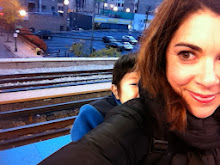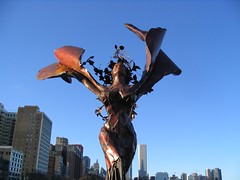Sight and touch
On Wednesday night around 9 p.m., I stood on the el platform after class (my very last class in grad school—come June I’ll have an M.A., and it only took four years!), waiting for the train. It had been a summer day in April, temperatures near 80 degrees, the undergrads schlepping around in wrinkled capri pants and rubber flip-flops (and me in my cotton grown-up workclothes, feeling old and overheated).
But now the air was incredibly, deliciously soft and warm and dark, brushing my cheeks, sliding through my hair. The city skyline was twinkling in the distance, Sears, Hancock, Aon, and the moon overhead was almost full. A beautiful night, its beauty sensed by both sight and touch…one of those small slices of loveliness that come when you least expect them.
Yesterday's weather was almost as nice, although a little cooler. I walked Moose in the park after work, my eyes unaccustomed to all the green—velvet green grass, pale green daffodil stalks, hedges covered in a light green mist. Blue sky. And for those of us who are white, pale legs and arms bared for the first time since September. The park was full of kids rollerblading and jump-roping and riding scooters. Two little Hispanic boys seemed very interested in Moose—I heard the Spanish word for dog, perro, whispered in a high-pitched voice—and so I stopped and asked if they wanted to pet him. They came over shyly, and somewhere in my mind I remembered the words: “Se nombre Moose,” his name is Moose. “Hi, Moose,” they said, stroking his head.
We kept walking, passing a young Eastern European mom and her toddler, a few homeless men, some Arab kids kicking a soccer ball, two young white joggers, the headphoned teenage boy who walks his neighbor’s ancient Bassett hound every afternoon. And then, out of the corner of my eye, I saw a tall, moving, black object, and I turned to see a woman in a burka walking on another path about 20 yards away. She was pushing a stroller with a toddler in it and leading a four- or five-year-old girl by the hand. The little girls wore pastel-colored coats with their hoods up. But the woman was dressed in a voluminous swath of black.
I didn’t want to openly stare at her, but I did steal a few more glances. I see women in headscarves around my neighborhood, but never women with their faces covered. I realized that this woman wasn’t wearing an actual burka, but a long, wide black dress, a long black headscarf, and another black scarf-like cloth that covered her face from the nose down. Her eyes were visible. (Perhaps what she was wearing was a chador; I’m not sure.)
Seeing her made me remember the night before, standing on the el platform with the warm breeze in my hair and on my cheeks. And although I don’t assume that the woman wanted my pity, I did pity her, for not being able to have that experience. I wondered, if she has a balcony, can she at least step outside at night, uncovered, to feel the air on her skin? Can she open a window and lean out, close her eyes and breathe the night air? I wondered if it’s difficult for young girls to begin wearing such a garment, when the days of not wearing one are still so fresh in their memories. I thought about how I had smiled at the two Hispanic boys and how they’d smiled back. What for me is an ordinary shared moment between strangers, a daily punctuation that some of my neighbors never experience.
But now the air was incredibly, deliciously soft and warm and dark, brushing my cheeks, sliding through my hair. The city skyline was twinkling in the distance, Sears, Hancock, Aon, and the moon overhead was almost full. A beautiful night, its beauty sensed by both sight and touch…one of those small slices of loveliness that come when you least expect them.
Yesterday's weather was almost as nice, although a little cooler. I walked Moose in the park after work, my eyes unaccustomed to all the green—velvet green grass, pale green daffodil stalks, hedges covered in a light green mist. Blue sky. And for those of us who are white, pale legs and arms bared for the first time since September. The park was full of kids rollerblading and jump-roping and riding scooters. Two little Hispanic boys seemed very interested in Moose—I heard the Spanish word for dog, perro, whispered in a high-pitched voice—and so I stopped and asked if they wanted to pet him. They came over shyly, and somewhere in my mind I remembered the words: “Se nombre Moose,” his name is Moose. “Hi, Moose,” they said, stroking his head.
We kept walking, passing a young Eastern European mom and her toddler, a few homeless men, some Arab kids kicking a soccer ball, two young white joggers, the headphoned teenage boy who walks his neighbor’s ancient Bassett hound every afternoon. And then, out of the corner of my eye, I saw a tall, moving, black object, and I turned to see a woman in a burka walking on another path about 20 yards away. She was pushing a stroller with a toddler in it and leading a four- or five-year-old girl by the hand. The little girls wore pastel-colored coats with their hoods up. But the woman was dressed in a voluminous swath of black.
I didn’t want to openly stare at her, but I did steal a few more glances. I see women in headscarves around my neighborhood, but never women with their faces covered. I realized that this woman wasn’t wearing an actual burka, but a long, wide black dress, a long black headscarf, and another black scarf-like cloth that covered her face from the nose down. Her eyes were visible. (Perhaps what she was wearing was a chador; I’m not sure.)
Seeing her made me remember the night before, standing on the el platform with the warm breeze in my hair and on my cheeks. And although I don’t assume that the woman wanted my pity, I did pity her, for not being able to have that experience. I wondered, if she has a balcony, can she at least step outside at night, uncovered, to feel the air on her skin? Can she open a window and lean out, close her eyes and breathe the night air? I wondered if it’s difficult for young girls to begin wearing such a garment, when the days of not wearing one are still so fresh in their memories. I thought about how I had smiled at the two Hispanic boys and how they’d smiled back. What for me is an ordinary shared moment between strangers, a daily punctuation that some of my neighbors never experience.
Labels: Chicago, Moose, neighborhood, spring

